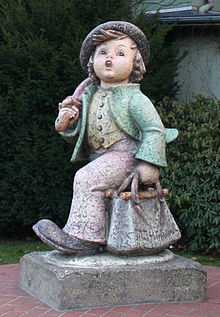Hummel figurines

Hummel figurines (also known as M.I. Hummel figurines or simply Hummels) are a series of porcelain figurines based on the drawings of Sister Maria Innocentia Hummel, O.S.F.
History
The sketch art of Sister Maria Innocentia began to appear in the 1930s in Germany and Switzerland, mostly pastoral drawings of children. The Swiss art publisher Ars Sacra was involved in the early popularization of the art on postcards. Hummel's "art cards" became popular throughout Germany, catching the eye of Franz Goebel, porcelain maker and head of W. Goebel Porzellanfabrik. Goebel acquired rights to turn Hummel's drawing into figurines, producing the first line in 1935.[1] Goebel was one of many mid-size porcelain firms competing in the US market and Franz Goebel´s knack for novelty marketing caused the figurines to become popular in the US during the 1930s. The base for the popularity was among German immigrants on the East Coast.
After the end of World War II, the popularity of Hummel figurines grew as American soldiers stationed in West Germany began sending the figurines home as gifts.[2] Nostalgia associated with the figurines and the U.S. soldiers buying them led to Hummel figurines becoming a popular collector's item. Popularity increased even more when the figurines were sold by the Army PX system. A vibrant speculator market in Hummel figurines developed and in the 1970s, Hummel figurines skyrocketed in price, though today most sell for less than $50.[3] M.I. Hummel collector plates made by Goebel and sold by the Goebel Collectors Club, were a prominent item in the Bradford Exchange, a supplier of collectible plates. Production of Hummel figurines by Goebel ended in 2008.[4] On-going production is by a new organization “Hummel Manufaktur GmbH”. [5]
Books about Hummel figurines
Many books and price guides have been published about Hummel figurines.[6] Some of these works supported the secondary market interest of collector speculators; The No. 1 Price Guide to M.I. Hummel, written by Robert L. Miller, is generally regarded as the definitive price guide.[7] The best selling quarto-size art book about Hummel figurines was authored by author Eric Ehrmann, who conducted extensive interviews with members of the family of Maria Innocentia Hummel and visited her ancestral home in Massing, Bavaria. Author Eric Ehrmann also visited the Kloster Siessen where Sister Hummel lived and sketched in Saulgau and interviewed Sister Radegundis Wespel, the director of the convent. He also conducted extensive research at the archives of W. Goebel Porzellanfabrik at Roedental, Bavaria, West Germany and interviewed workers as well as executives of the company including Wilhelm Goebel himself. The large art book format featuring life-size color photography of the figurines was an overnight success in the summer of 1976 when it was published by the Portfolio Press of Huntington, New York.
Museums
Donald Stephens, longtime mayor of Rosemont, Illinois, was a prolific collector of Hummel figurines. In 1984, Stephens donated his collection to the Village of Rosemont to be displayed in a museum. The Donald E. Stephens Museum of Hummels opened in its current location in Rosemont on March 13, 2011.[8] The museum purports to be the largest collection of Hummel figurines in the world.[9]
In popular culture
Hummel figurines have been referenced multiple times in popular culture. On the television series Seinfeld in the episode "The Pony Remark", there is a reference to Jerry's auntie's Hummel collection and in Glee, the character "Kurt Hummel" is named for the Hummel figurines.[10] On the television series Gilmore Girls, a Hummel collection of Kyle's mother is broken during the fight between Dean and Jess (season 3, episode 20). In the web series Ask That Guy With The Glasses, Hummel figures are implied to be satanic. In the 2004 comedy film Team America: World Police, Kim Jong-il can be seen walking past his collection of Hummel figurines when he sings "I'm So Ronery." In a 2011 episode of "The Mentalist," human behavioral expert (and the titular "mentalist") Patrick Jane is surprised to learn "supercop" J.J. Laroche, a CBI chief, collects Hummel figurines when Jane visits Laroche's home for the first time. The Simpsons' sixteenth season episode "Home Away From Homer" reveals that Ned Flanders has a sizable collection of "Humble" figurines, a parody of Hummels. The Simpsons' also references Hummel figurines in the episode "Principal Charming" when Marge mentions that her sister Selma enjoys Hummel figurines. In the movie "About Schmidt" the title character buys some Hummel figurines at an antique store in memory of his wife who collected the figurines. In the Richard Bachman novel, The Regulators, Johnny enters the Carvers' home and laughs under his breath at their Hummel figurines which have been placed on little platforms. On the Breaking Bad spin-off Better Call Saul, an elderly lady drawing up her will calls on Saul's excellent memory when it comes to distributing her Hummel collection.
References
- ↑ M.I. Hummel. "About M.I. Hummel". Retrieved April 14, 2011.
- ↑ Donald E. Stephens Museum of Hummels. "History M.I. Hummel Figurines". Retrieved April 14, 2011.
- ↑ Zac Bissonnette. "Kitsch and Capitalism: The Rise and Fall of Hummel Figurines". Retrieved April 18, 2011.
- ↑ News-Antique.com. "Goebel Germany will discontinue production of M.I.Hummel figurines". Retrieved April 18, 2011.
- ↑ mihummel.de. "Latest News". Retrieved December 28, 2014.
- ↑ Hummels.com. "Hummel Books". Retrieved April 18, 2011.
- ↑ M.I.Hummel Club. "Frequently Asked Questions". Retrieved April 18, 2011.
- ↑ Journal Online. "Rosemont's Hummel Museum Opens". Retrieved April 14, 2011.
- ↑ Donald E. Stephens Museum of Hummels. "The Donald E. Stephens Collection". Retrieved April 14, 2011.
- ↑ "The Tonight Show with Conan O'Brien". Retrieved December 3, 2009.
External links
- Manufaktur Rödental. Home Page. retrieved April 14, 2011
- W. Goebel Porzellanfabrik GmbH & Co. KG. Goebel. "About M.I. Hummel" retrieved January 12, 2007
- W. Goebel Porzellanfabrik GmbH & Co. KG. M.I. Hummel. "Craftsmanship". retrieved January 12, 2007